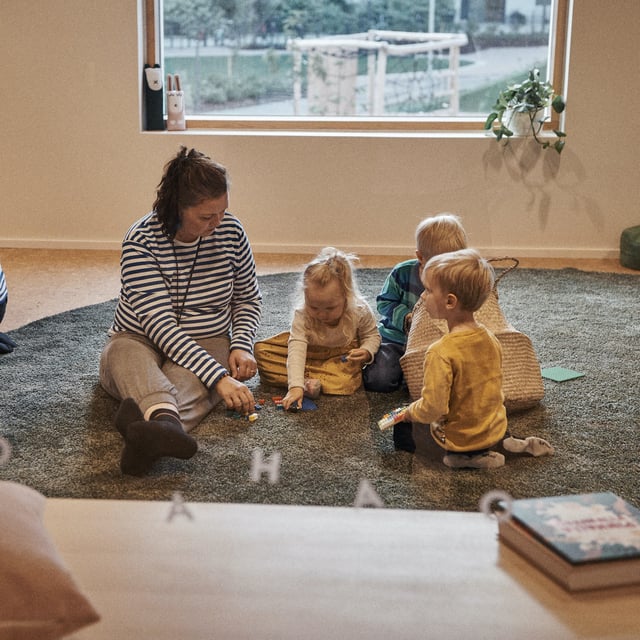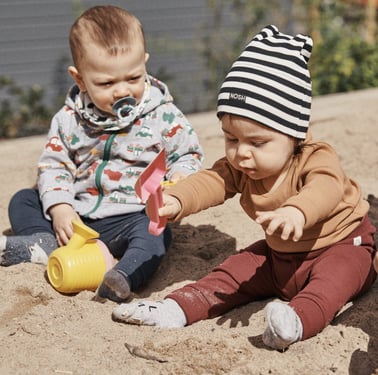Montessori & Finland's Education differences: Philosophy & Environment

Part 1 covers the history of each education
Part 2, this article, explores their shared philosophy, as well as the learning environment and materials.
Part 3 discusses daily life at school, standardization, and development.
Their Shared Philosophy: A Child-Centered Approach
The greatest similarity between the Montessori and HEI Schools philosophies is that they are both child-centered. Grounded in the belief that early childhood is a time when children should be free to explore their interests and discover new things, they emphasize the importance of letting children take the lead in their own learning. Allowing children active agency, freedom of choice and age-appropriate independence are all key principles of these frameworks.

Developmental Phases are Key
Both models account for the developmental phases, strengths and personality of each child. They take a holistic approach to teaching because they recognize children as individuals, which means that they learn differently. Therefore, the classroom environment serves a variety of learning styles and let children learn at their own pace.
The two models also integrate the ‘sensitive period’ of learning into their approaches. Proven by research, this concept is grounded in the idea that there are certain periods of development in which children are most receptive to certain types of learning. Their brains are incredibly flexible and growing exponentially, so it is much easier to learn certain skills during such developmental phases than it would be later on. For example, preschool-aged children are particularly adept at language learning, so they should be exposed to language as much as possible so that they can learn new words and even new languages effectively.
Focusing on Children's Strengths
Besides that, the Montessori and HEI Schools models both focus on developing and building upon children’s existing abilities, which makes them feel confident and capable of learning more. The educators also scaffold new skills that children need some help with, thereby respecting their current skills and helping them grow in a way that is healthy and natural. Both models therefore empower children, build a strong foundation of internal motivation and instill a lifelong love of learning.
The models work quite well together too! You can read our case study about a Montessori school that uses the HEI curriculum, the HEI Schools Toolkit, to learn how they integrated the two approaches.
The Learning Environment and Materials

A typical Montessori classroom (Source: Natalie Cho, WikiCommons)
Premeditated Outcomes in Montessori
A "Prepared Environment"
While both the Montessori and HEI Schools models have child-centered philosophies, their classroom environments are quite different. In a Montessori school, children learn in a “prepared environment:” there are child-sized tables and chairs, practical household items, and a variety of toys and tools in easily accessible locations.

Montessori counting materials (Source: Thacher Montessori School, WikiCommons)
The learning materials themselves are organized within the classroom by curriculum area: Practical Life, Sensorial, Mathematics, Language and Culture. Scientifically developed to align with appropriate levels of development, each toy is designed to accomplish a certain goal within a curriculum area, regardless of how the child initially perceives them. The teacher demonstrates how to complete each task, and the children are expected to copy them. For example, in the practical life section, bottle caps help children learn how to open bottles and buttons help them learn how to button.
Sensory & Real-Life Learning Experiences
Montessori learning materials are intentionally sensory so children can engage all of their senses in the learning experience, which aids their intellectual development. They also focus on occupational education and real-life skills. Tools from ‘real life,’ such as glass cups, knives, brooms and watering cans, give children the opportunity to develop practical skills like cooking, cleaning and gardening. Because many tools are delicate or fragile, children learn how to handle these objects with care and practice their fine motor skills.
The "Control of Error"
All Montessori learning materials are built with a control of error. This means that they are meant to be used in a certain way, and it is obvious when a child uses something ‘incorrectly.’ For example, if a child builds a structure and makes a mistake, a piece will be left out or the pieces do not fit together properly. Because of this, the child can 'fix’ the error without adult instruction. While this encourages independent action and autonomy, it does not actively foster unconventional creative thinking. Children perceive that there is only one correct way of doing something, so there is no room for further exploration or discovery.
Worlds of Possibility in HEI Schools
Learning Everywhere and All the Time
HEI Schools, on the other hand, does not have traditional classrooms. Instead, we provide a variety of learning spaces that serve multiple purposes. According to the HEI Way, learning happens everywhere and all the time, which means learning is not limited to certain experiences or spaces - all places are learning spaces. For example, the HEI Base is a large, open area where children play freely and have activity-based learning sessions with the teacher. HEI Downbeat is a smaller area where children can nap and rest without distractions. HEI Workshop is another spot for crafts, activities and free play.
Some examples of less obvious but equally important places for learning are the restroom, hallway and HEI Cafe. In the restroom, children learn basic life skills, like how to use the toilet, wash their hands and take care of their personal hygiene. In the hallway, they learn how to walk in an orderly fashion, navigate their space and greet others in passing. In the HEI Cafe, children enjoy meals together with their teacher, learn culturally appropriate table manners and develop healthy eating habits.
It should be noted that children sit and eat with their teachers in a Montessori setting as well, and they teach similar skills. Unlike HEI Schools educators, Montessori teachers do not necessarily show children how to use the restroom or walk down the hallway in an intentional way. Though these moments might seem insignificant from a traditional perspective, they provide significant learning opportunities for children that are just as important as traditional learning.
Limiting Distractions
Unlike Montessori's prepared environment, HEI learning spaces do not have all of the toys and tools on display. Scaling for age, HEI Schools Learning Centers display some learning materials, such as books on child-sized trolleys and other materials on shelves, but many of our learning materials are out of sight, stored in predictable spaces for children to easily access. That way, the learning space is relatively free from distractions.
HEI School learning spaces also use natural colors and materials in order to minimize visual and audio noise and create a calming atmosphere. This open space allows children to use their imagination and explore. Research also proves this is be beneficial for more active children because there is less visual distraction.
Interested in this sort of research? We have a whole article that delves into the science behind our design.
The Importance of Nature
Another key aspect of HEI Schools is its emphasis on nature and spending time outdoors. Finnish early education guidelines recommend at least two hours of outdoor time every day, regardless of the weather. The HEI Schools Curriculum has similar recommendations, and while such guidelines are adapted to suit local needs, all Learning Centers include the HEI Outdoors as a conceptual learning space. Here, children have less boundaries than they do indoors - they can run, shout and feel free, which is very healthy and natural for them.
 Being outdoors also gives children a chance to experience nature. One of the HEI Way’s cornerstones is cultivating a sustainable way of living, and in order to do that, children must first establish and build a strong relationship with nature and the earth. HEI Field Trips provide children with opportunities to explore the natural surroundings, and we encourage local teachers to find natural spaces near their schools that they children can regularly visit.
Being outdoors also gives children a chance to experience nature. One of the HEI Way’s cornerstones is cultivating a sustainable way of living, and in order to do that, children must first establish and build a strong relationship with nature and the earth. HEI Field Trips provide children with opportunities to explore the natural surroundings, and we encourage local teachers to find natural spaces near their schools that they children can regularly visit.
Want to learn more about outdoor learning? Two of our pedagogical experts discuss the topic and provide example activities in our special webinar.
Open-ended Learning Materials
As for learning materials, HEI Schools draws inspiration from Montessori and even incorporates many of its tools into its own learning materials. However, unlike Montessori, HEI Schools learning materials allow for and even encourage different approaches.There are many intentionally open-ended materials in HEI Collection that have no specific method of use. For example, each HEI Schools Learning Center has climbing ladders, unusually shaped wooden blocks, adaptable train sets and more. Though children learn how to use certain tools, such as paintbrushes, they are free to explore and utilize many learning materials in a variety of creative ways.
HEI Pictograms: Another Way to Communicate

One unique example of the learning materials offered at HEI Schools is our set of HEI Pictograms. These cards illustrate objects, activities, emotions, concepts, days of the week and more with graphic pictures and the corresponding English term. Teachers utilize them in a variety of ways throughout the day, and the pictograms given children an alternative way to communicate, interact and learn the English language.
For example, children can make choices based on HEI Pictograms, which simplifies the incoming information, or they can use emotion pictograms to express their feelings. HEI Pictograms are also helpful for children who have little or no English skills because the pictures allow them to participate and engage with the visual representations on the cards and slowly build their language abilities.
HEI Pictograms play an important role in the learning spaces as well. They label certain areas and the locations of learning materials, like arts and crafts materials. Therefore, children can easily find and return supplies, which contributes to their sense of independence and responsibility. HEI Pictograms are also used to show the daily schedule. This helps children feel less anxious, because they know what the day will entail, and more independent because they can prepare for each part of the day as it comes.



-1.png?width=352&name=children%20looking%20in%20(1)-1.png)
.jpg?width=352&name=HEI%20Schools%20Introduces%20Finnish%20Education%20to%20India%20at%20the%20Embassy%20of%20Finland%20in%20Delhi%20(2).jpg)
